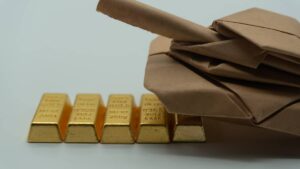Battery metals could see a new commodity cycle that outlasts even the booms of old

Pic: Bloomberg Creative / Bloomberg Creative Photos via Getty Images
Veteran stockbroker Eddie Rigg says the current resources upswing will last longer than previous booms as battery metals dominate the capital investment landscape.
Speaking at the RIU Resurgence Conference in Perth this week, the head of WA brokerage Argonaut said the current resources cycle could last for years.
Rigg’s comments came just after the ABS revealed Australian miners and explorers tipped a near record $982 million into exploration in the September quarter.
“We’re a great believer at Argonaut that this cycle is going to be far longer than previous cycles which can be a bit boom and bust,” he said.
Supply challenges, energy transition drive commodity prices
A cocktail of post-pandemic stimulus measures, supply disruptions, the increasing capital costs of making discoveries, approvals delays and need for battery metals for the energy transition were great for commodity prices, according to Rigg.
“Reasons for it and for reasons that I think most people accept is that Covid has caused a dampening on supply response,” he said.
“That’s a big thing, we can’t get people … the disruption in logistics.
“We’re also seeing that the approval process and all the various industry charges and challenges particularly in Australia after Juukan Gorge, trying to get things approved now, what might have taken six months will take two years or more.
“There’s also increasing sovereign risk around the world and of course orebodies are more commonly now blind so it takes a lot more to discover these orebodies.
“So we believe this cycle is a much elongated cycle and it’s great for everyone in this room.”
Rigg says “copper is king” and believes the investment booms driven by iron ore and coal in the 2000s and then by gold developments in recent years will give way in the next decade to capex on energy transition commodities.
“The first decade was really driven by iron and coal, the last 10 years was really driven by gold and our view is going forward there’s only one way to supply the materials which are required to now move to decarbonising this world we live in,” he said.
Electrification driving positive future for battery metals
The state of play outlined by Rigg has base metals miners and explorers’ tails up about the outlook for their sector.
While Rigg views copper as the commodity poised to benefit most from its role in the decarbonisation and electrification of everything including solar, wind, bioenergy, electricity transmission and EVs, metals like nickel, tin and lithium are also seeing their day in the sun.
Venture Minerals (ASX:VMS) boss Andrew Radonijc, whose firm owns the Mount Lindsay tin-tungsten project in Tasmania, said their core commodity is playing into the electrification theme.
Tin is a key component of electronics in the form of solder, and prices have climbed to records of around US$40,000/t this year on supply disruptions.
“Work from home has just escalated the use of anything that’s electric,” Radonijc told delegates at the RIU Resurgence Conference.
“Anything that’s got circuitry in it has got solder and solder is 96% tin now.
“10 years ago when tin was about US$30,000/t, it was about converting to lead-free solder.
“Miniaturisation was a threat and that’s what caused the tin price to go down. But I don’t know about you but mobile phones seem to be getting bigger and we seem to have more of them.”
Radonijc believes the “green industrial revolution” could send prices on a ride.
“As we go into this green industrial revolution where we’re going to electrify everything then tin is going to go on for a ride,” he said.
“We’ve seen the price, it’s in electric vehicles, wind power, tin-copper solar cells, energy storage and in lithium ion as well as lead-acid batteries.
“It’s very synonymous with the future the way that it’s going, that’s why the price is where it is today and I can only see it getting higher.”
Venture Minerals share price today:
Valuations soar for battery metals companies
Winsome Resources (ASX:WR1) is one of the latest beneficiaries of the fever for battery metals in equity markets.
The MetalsTech (ASX:MTC) lithium spinoff listed on Tuesday after an $18 million IPO raising, soaring 60% beyond its 20c listing price over the company’s first two days of trade to 32c.
Managing director Chris Evans told the conference Winsome received applications for four times that amount, against the backdrop of a more than 300% rise in prices for the quintessential battery metal in 2021.
Winsome owns three lithium exploration projects in Quebec, Canada.
One, Sirmac-Clappier, is just down the road from Moblan, a “world-class” project ASX-listed Sayona Mining (ASX:SYA) paid US$86.5 million for 60% of in September.
“It’s got a resource of about 12Mt at about 1.4% lithium oxide and to establish that resource they had 17,000m of diamond drilling,” Evans noted, adding that Winsome has already completed 5500m of drilling at its Cancet project, where the company has an exploration target of 15-25Mt at 1-2% Li2O.
“Sayona purchased 60% of their project for US$86 million, which values (it) roughly at US$144 million for the full project, roughly $200 million Australian.
“The fact we listed with an EV of $9 million yesterday, our market cap is sitting at $38 million, shows the real potential for our projects.”
Argonaut’s Rigg said a $10,000 investment made in “new world commodities” at the start of 2021 would have generated returns of $17,300 today, against just $12,400 for “old world commodities”.
Winsome Resources share price today:
At Stockhead, we tell it like it is. While Venture Minerals is a Stockhead advertiser, it did not sponsor this article.
Related Topics

UNLOCK INSIGHTS
Discover the untold stories of emerging ASX stocks.
Daily news and expert analysis, it's free to subscribe.
By proceeding, you confirm you understand that we handle personal information in accordance with our Privacy Policy.








